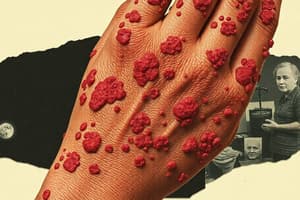Podcast
Questions and Answers
What type of hypersensitivity reaction is associated with Lichen Planus?
What type of hypersensitivity reaction is associated with Lichen Planus?
- Type II hypersensitivity reaction
- Type I hypersensitivity reaction
- Type IV hypersensitivity reaction (correct)
- Type III hypersensitivity reaction
What is a characteristic feature of the skin lesions in Lichen Planus?
What is a characteristic feature of the skin lesions in Lichen Planus?
- Red, scaly patches
- Yellow, crusty lesions
- White, raised nodules
- Purple, pruritic, polygonal papules (correct)
Which population is most commonly affected by Lichen Planus?
Which population is most commonly affected by Lichen Planus?
- Children under 10 years old
- Young adult males
- Elderly individuals over 65 years
- Middle-aged adults, more commonly females (correct)
Where are oral lesions from Lichen Planus most commonly found?
Where are oral lesions from Lichen Planus most commonly found?
Which form of Lichen Planus is characterized by painful gingiva and may present with erosions or ulcers?
Which form of Lichen Planus is characterized by painful gingiva and may present with erosions or ulcers?
Flashcards are hidden until you start studying
Study Notes
Lichen Planus
- Chronic inflammatory disease affecting the skin and oral mucosa
- Estimated to affect ~2% of the population
- More common in middle-aged adults, with women being affected more often than men.
- Cause is unknown, but it is associated with stress.
- Considered a Type IV hypersensitivity reaction.
Skin Lesions
- Characterized by purple, itchy, polygonal papules.
- Overlying Wickham striae, fine white lines that sit on the papules.
- Can occur anywhere on the body, but commonly seen on the lumbar region, flexor surfaces of wrists and elbows, and anterior surface of ankles.
Oral Lesions
- Most common on the buccal mucosa.
- May also involve the tongue, lips, floor of mouth, and gingiva.
- Lesions are often bilaterally symmetrical.
Forms
- Reticular: Most common form, asymptomatic, characterized by Wickham striae with white plaque-like areas.
- Erosive: Presents with erosions, bullae, or ulcers.
- Desquamative gingivitis: Erythematous, painful gingiva, this clinical term may also indicate pemphigus or pemphigoid.
Studying That Suits You
Use AI to generate personalized quizzes and flashcards to suit your learning preferences.




